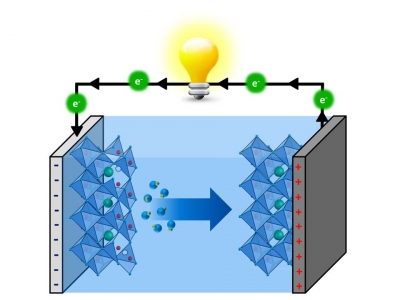While the sun and wind provide great alternative energies, the supplies can be highly variable when the sun isn’t shining or the wind isn’t blowing. Also consider the Achilles' heel of electric vehicles: it can take hours to recharge them.
To solve these seemingly unrelated problems, scientists and engineers have been developing energy storage devices called pseudocapacitors that can charge and discharge much faster than commercial batteries. Combined with batteries, they offer the best of both worlds, long term energy storage and rapid charging.
 Now, scientists in the The University of Texas at Austin's College of Natural Sciences and the Cockrell School of Engineering, in collaboration with a researcher at the Department of Energy’s Oak Ridge National Laboratory, have developed the first of a new class of pseudocapacitor that may eventually lead to devices that can store electricity more densely and charge/discharge more quickly than other types of pseudocapacitors built to date.
Now, scientists in the The University of Texas at Austin's College of Natural Sciences and the Cockrell School of Engineering, in collaboration with a researcher at the Department of Energy’s Oak Ridge National Laboratory, have developed the first of a new class of pseudocapacitor that may eventually lead to devices that can store electricity more densely and charge/discharge more quickly than other types of pseudocapacitors built to date.
In the journal, Nature Materials, the team led by professor Keith Stevenson reports a new energy storage mechanism for pseudocapacitor electrodes that promises to boost the energy density and power density of pseudocapacitor devices. Unlike other devices, the team's is the first to utilize oxygen anions (negatively-charged ions) instead of cations (positive ions) to store its energy.
“One main advantage of oxygen ions is that they can allow you to theoretically store double the energy, providing two electrons per ion stored,” said Tyler Mefford, graduate student and lead author of the study. “It’s also a proof of concept that this kind of charge storage strategy can work, so we can continue research in this area to make them better and better.”
He hopes that one day the technology will advance enough to charge electric cars in minutes instead of hours and improve load leveling on electric grids.
The device uses a type of material called perovskite, a unique structure containing vacant sites where oxygen anions can be stored, making these advancements a possibility.
“It's already competitive with a lot of the cation ones but there may be even better anion-based materials out there,” Mefford said. “Another benefit is that the really high performing cation-based pseudocapacitors use metals that are really expensive and not abundant on earth, while the materials used in this anion-based one uses cheap metals that are abundant in earth’s crust.”
Oak Ridge National Laboratory chemist Sheng Dai developed an energy-storage technology for the project, which received funding from the U.S. Department of Energy’s Office of Science.
Pseudocapacitors and batteries are already used in regenerative braking and acceleration systems in electric vehicles because batteries themselves can’t deliver energy fast enough for acceleration.
“People want to use electric vehicles and we want to go to a smart grid, but energy storage is one of biggest things holding us back,” said Mefford.

















Comments